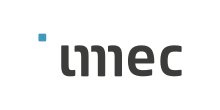IMEC
 | |
| Company type | Nonprofit company |
|---|---|
| Industry | micro- and nano-electronics,solar cell |
| Genre | Independent research center |
| Founded | 1984 |
| Founder | Prof. Roger Van Overstraeten |
| Headquarters | Leuven , Belgium |
Key people | Luc Van den hove, CEO |
| Services | Research, Education |
Number of employees | 1,700 |
| Website | www.imec.be |
50°51′55.5″N 4°40′46.5″E / 50.865417°N 4.679583°E IMEC (Interuniversity Microelectronics Centre) is a micro- and nanoelectronics research center located in Leuven, Belgium with affiliated laboratories throughout Flanders. IMEC focuses on next generation electronics research, three to ten years ahead of industrial needs. The organization employs approximately 1,700 people.
IMEC's mission
To perform R&D, ahead of industrial needs by 3 to 10 years, in nanoelectronics, nanotechnology, design methods and technologies for ICT systems.
This mission is backed by 3 trends in the electronics industry:
More Moore – Scaling electronic devices and circuits will continue into the next decade; it will be driven by Moore’s Law, following the technologies described in the International Technology Roadmap for Semiconductors (ITRS). CMOS will remain the main semiconductor technology platform in the foreseeable future.
More than Moore – Current CMOS processes can be used to develop new micro- and nanodevices with extended functionality such as sensors, MEMS, or NEMS. More than Moore technologies include heterogeneous integration, advanced packaging, 3D integration, biomedical electronics, autonomous embedded appliances, and photovoltaics.
Convergence of More Moore and More than Moore – Scientists envision an increasing need to combine higher performance (More Moore) with complex and extended functionalities (More than Moore). This convergence will impact IC design, processing, integration, and packaging. Further scaling will create new opportunities for heterogeneous integration—think of nano-bio convergence. But mastering the integration of complex nanoscale components will require disruptive methods. Leading players in complexity, such as IMEC, have a substantial advantage in the development of such future nanoelectronic systems.
History
The history of IMEC dates back to 1982 when the Flemish government started a comprehensive program in the field of microelectronics to strengthen the microelectronics industry in Flanders.
One of the initiatives of the Flemish program was the establishment of a laboratory for advanced research in microelectronics, which was to become IMEC. IMEC built on the academic reputation and prominence of the Catholic University of Leuven (Katholiek Universiteit Leuven, or 'KUL') and in particular its ESAT laboratory. Another initiative was a training program for VLSI design engineers (INVOMEC & MTC, Microelectronics Training Center, now incorporated in IMEC).
IMEC started in 1984 as a non-profit organization led by Professor Roger Van Overstraeten (Catholic University of Leuven), and under the supervision of a Board of Directors, with delegates from industry, Flemish universities, and the Flemish government. In June 1999, Professor Gilbert Declerck succeeded Roger Van Overstraeten as IMEC's CEO.
In 2005, IMEC and TNO set up Holst Centre. Holst Centre is a research center with the mission to create generic technologies and enhance the innovative power in the fields of Wireless Autonomous Transducer Solutions and Systems-in-Foil. Holst Centre is located on the High Tech Campus in Eindhoven, the Netherlands.
By 2008, IMEC has grown into one of the world's premier micro- and nanoelectronics R&D centers, employing some 1,600 researchers and engineers. Crucially, IMEC now counts virtually all of the top semiconductor manufacturers among its core technology partners (eg Intel, Samsung, STMicroelectronics, NXP Semiconductors, TSMC, Hynix, etc.) as well as most of the major capital equipment developers and manufacturers.
IMEC hosts a number of yearly renowned conferences and technology review meetings (eg ARRM, UCPSS), and provides a unique space where new technologies and techniques can be assessed, developed, refined and validated.
Campus
The IMEC campus has 24,400m2 of office space, laboratories, training facilities, and technical support rooms. Showpieces are the two cleanrooms that run a semi-industrial operation. The newest infrastructure, compatible with the latest 300mm wafer standards, supports the More Moore research on (sub-) 32nm process technology. The second cleanroom handles wafers with a diameter of up to 200mm and is used for the More than Moore research. It supports semiconductor manufacturing processes with added functionality, such as sensors, actuators, and MEMS and NEMS. IMEC is currently in the process of extending it's newest cleanroom facility and completion of the project is set for the Summer 2010.
IMEC has, among others, a pilot line for silicon solar cells, unique laboratories for bioelectronics research, and state-of-the-art equipment for materials characterization and reliability testing. For the research on nomadic embedded systems, there are a DSP and multimedia lab, and the latest EDA tools.
Research domains
- CMOS-based nanoelectronics
- Nanotechnology and post-CMOS nanoelectronics
- Characterisation, reliability and modelling
- Multi-mode multimedia (M4) technologies
- Wireless autonomous transducer solutions
- Solar cells
- Large-area CMOS-based Image Sensors (Back-illuminated CIS)
- Advanced packaging and interconnection technologies ([Bumping], [WLP])
- 3D-chip stacking (Through-Silicon Vias)
- Power-efficient devices based on III-V Materials (GaN, GaAs...)
- Bioelectronics and Neuroprosthetics
- Organic electronics
- RF devices and technology
- MEMS for RF and millimeterwave applications
- Design methodologies and technology in the context of EDA
- Power MEMS
See also
- Flanders Technology International
- Institute for the promotion of Innovation by Science and Technology (IWT)
- Science and technology in Flanders
